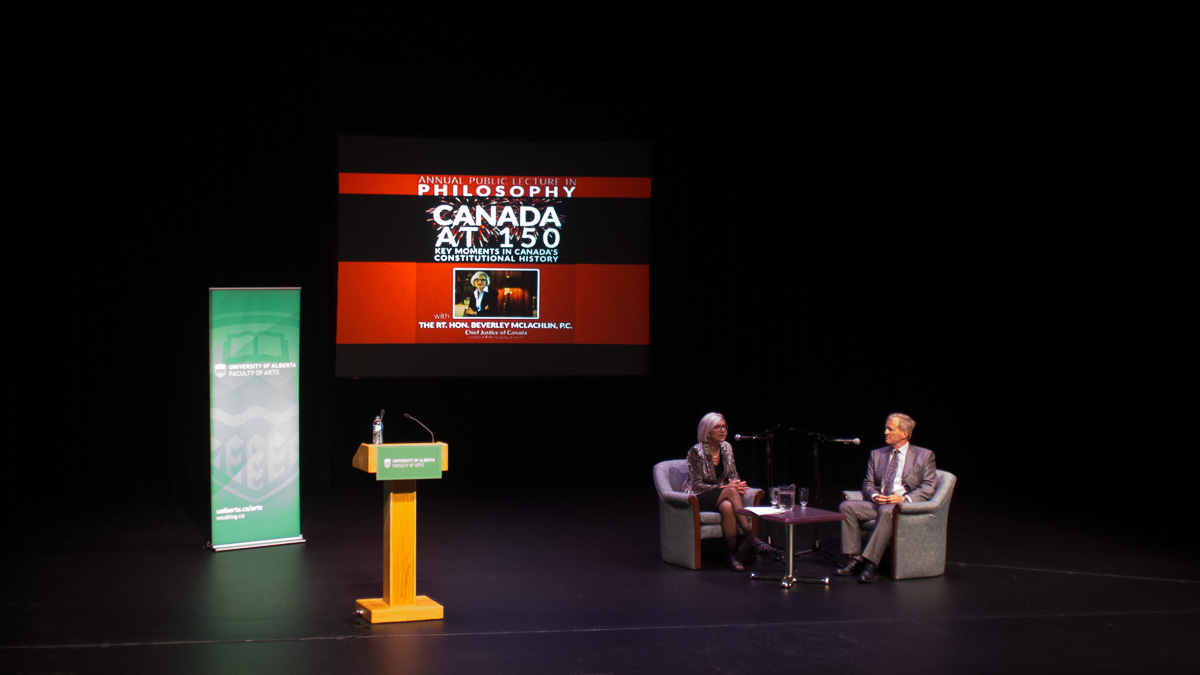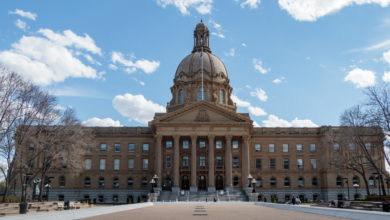Supreme Court Chief Justice and U of A alumna Beverley McLachlin gives talk on diversity
 Joshua Storie
Joshua StorieAt the Timms Centre of the Arts on Wednesday, September 6, Chief Justice Beverley McLachlin spoke about the importance of diversity and how embracing it is one of Canada’s defining features.
As part of the Department of Philosophy’s annual public lecture series, McLachlin, who studied philosophy at the U of A in the 1960’s, focused her lecture on five key moments in Canada’s constitutional history and how these moments demonstrate Canada’s commitment to diversity and inclusion.
McLachlin was appointed to the Supreme Court in 1989 by Prime Minister Brian Mulroney and was then made Chief Justice of Canada in 2000 by Prime Minister Jean Chretien. She is the first female Chief Justice, and also the longest-serving person in that role. During her time in the Supreme Court, several significant rulings have been made, including striking down anti-prostitution laws and laws against doctor-assisted death. Earlier this year, McLachlin announced that she will be retiring in December 2017.
In her talk at the U of A, McLachlin argued for Canada’s inclusive character, however she acknowledged that it has failed that commitment on several occasions in the past, such as during residential school programs and the head tax on Chinese immigrants.
“We are still trying to mend these wounds and are reminded that policies of exclusion are detrimental, have always been detrimental, to the country as a whole,” McLachlin said.
Despite these moments, McLachlin argued that Canada’s ethic of inclusion has persisted in the 150 years since Confederation.
Following her lecture, the audience asked McLachlin several questions, including how her studies in philosophy at the U of A have helped her work as a judge.
“Before I started studying philosophy, my mind was a bit of a mess,” she said. “It was very muddy, and I felt that that discipline and all that constructive criticism that I got from people in the philosophy department really helped me to learn how to better marshal arguments.”
McLachlin was also asked if she had any advice for countries in Europe that are closing their borders to immigration. While she said she had no advice to give in public, she elaborated further on how countries can react to diversity.
“Diversity today is inevitable,” she said. “Poland, Hungary, all these countries that are perhaps opting to diminish diversity, they have diversity, it’s a question of how you react to it. Do you react to it in an inclusionary way that is based on a fundamental belief that all human beings are worthy of dignity and to be treated as such, or do you react to it in some other way?”
Finally, McLachlin was asked if the Supreme Court is open to reconsidering the way it communicates with the public. She replied with a reference to Donald Trump and his tweeting habits.
“The Supreme Court does have a Twitter account, but you won’t get any 4:00 a.m. tweets from me,” she said.





McLachlin was involved in at least two Supreme Court decisions that curbed aboriginal rights.
Section 35 of the 1982 Constitution Act gave constitutional status to existing aboriginal and treaty rights.
But due to subsequent rulings, “the practice, tradition or custom (to which the aboriginal right pertains) must have been integral to the distinctive culture of the aboriginal people in the sense that it distinguished or characterized their traditional culture and lay at the core of the aboriginal people’s identity.” And, despite this talk of protecting rights, Section 35 came to involve the stipulation that “the government retained the jurisdiction to limit aboriginal rights for justifiable reasons in the pursuit of substantial and compelling public objectives.”
Mitchell in 2001 was a case involving a Mohawk chief who crossed from the US to Canada with things he bought, and claimed he didn’t have to pay duty because of his aboriginal rights. According to the ruling: “the test to establish an aboriginal right focuses on the integral, defining features of the relevant aboriginal society before the Crown’s assertion of sovereignty. A claimant must prove that a modern practice, custom or tradition has a reasonable degree of continuity with a practice, tradition or custom that was in existence prior to contact with the Europeans.”
The court, including McLachlin, ruled that of the evidence presented (including oral history), none of it proved that what Mitchell did, freely crossing the St. Lawrence River bearing some stuff, was an ancestral practice, although this obviously would have happened before Europeans showed up. It wouldn’t have mattered anyway, since crossing the St. Lawrence River with some stuff wasn’t at the core of aboriginal identity.
Marshall in 2005 was another case involving McLachlin, regarding logging on Crown land. “The accused argued that as Mi’kmaq Indians, they were not required to obtain provincial authorization to log because they have a right to log on Crown lands for commercial purposes pursuant to treaty or aboriginal title.” The ruling: “the evidence supports the trial judges’ conclusion that the commercial logging that formed the basis of the charges against the accused was not the logical evolution of a traditional Mi’kmaq trading activity in 1760-61.”
Many aboriginal rights have difficulty being translated into the modern era. The way Section 35 has been interpreted is by failing to recognize dynamic change that comes with time and capitalism. Even bringing certain things to court can be trouble for aboriginal people because often those rights become defined then limited. The colonial legal legacy has been of presenting aboriginal people with “damned if you do, damned if you don’t” decisions.
Even the MMF ruling that should feel like a victory isn’t without irony. The Metis were awarded land because the government committed consistent error and negligence in fulfilling its promise. But consistent error and negligence seem to be acceptable when such things occur as a result of law itself (Indian Act and INAC). Failing to honour the law will lose court cases, but following ineffective law will win court cases. Included in the ruling too is one of the most insidious uses of reconciliation discourse you’ll find: “the reconciliation of pre-existing Aboriginal societies with the assertion of Crown sovereignty.”
Section 35 and later interpretations granted significant power to Crown sovereignty. Whether or not McLachlin was just carrying out what the law said doesn’t deter from the fact that part of her legacy was maintaining the law as a major obstacle to a lot of aboriginal people having a fighting chance, let alone succeeding. The “woman who rose through the ranks of men” narrative is likeable enough, until you realize that woman limited the rights of aboriginal women. In a way her Chief Justice career has been almost stereotypical of Canadian liberalism: pro-LGBT, pro-assisted suicide, pro-free speech, pro-diversity. In principle, pro-aboriginal. In practice, it’s the same old fit in or fuck off.
Nathan, an excellent and well written article. Globe and Mail calibre work. I wish I had known about this earlier and been able to listen to Chief McLachlin. Always cool to have UofA alumni making the world a better place.
Nathan, an excellent and well written article. Globe and Mail calibre work. I wish I had known about this earlier and been able to listen to Chief McLachlin. Always cool to have UofA alumni making the world a better place.